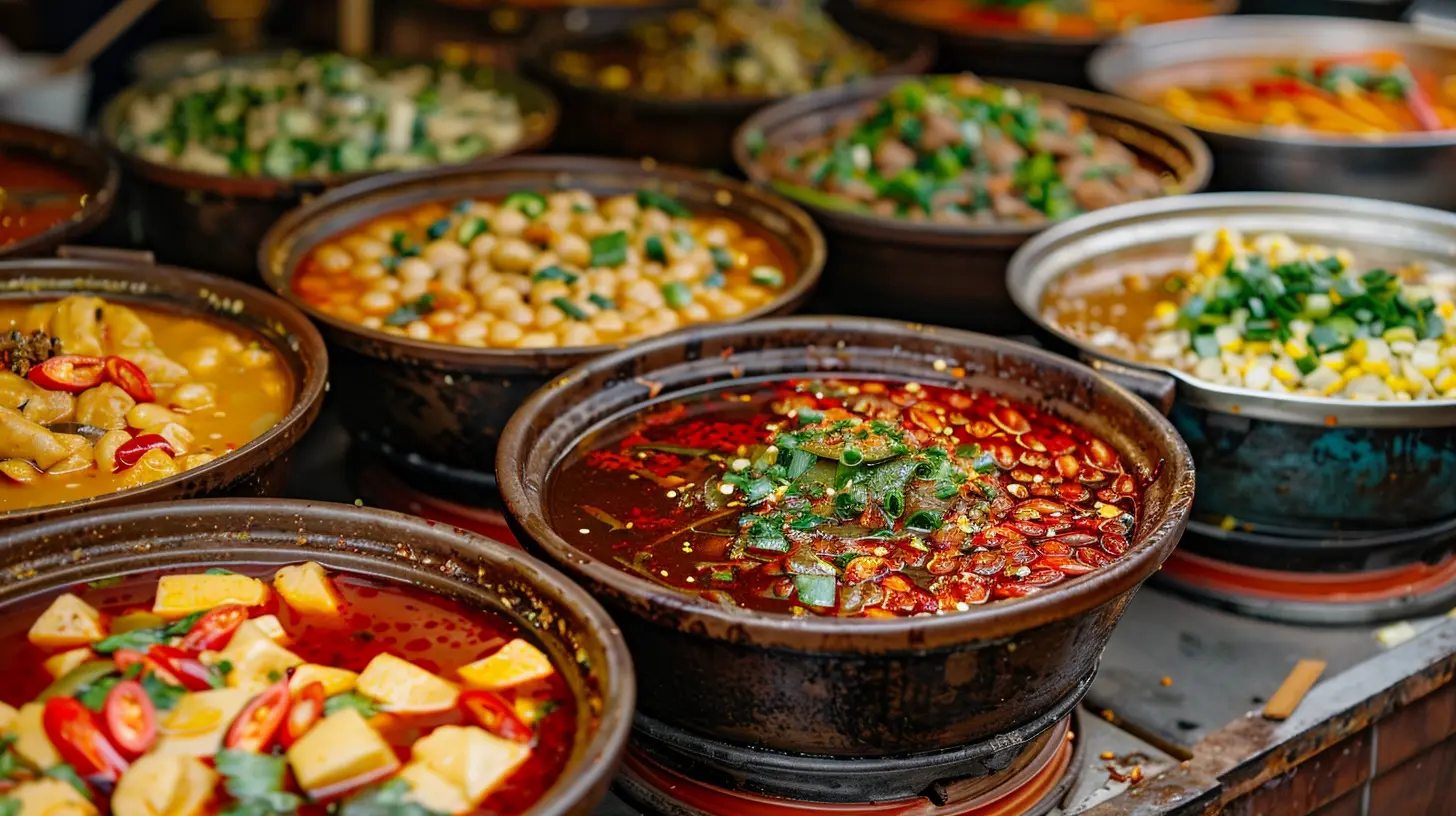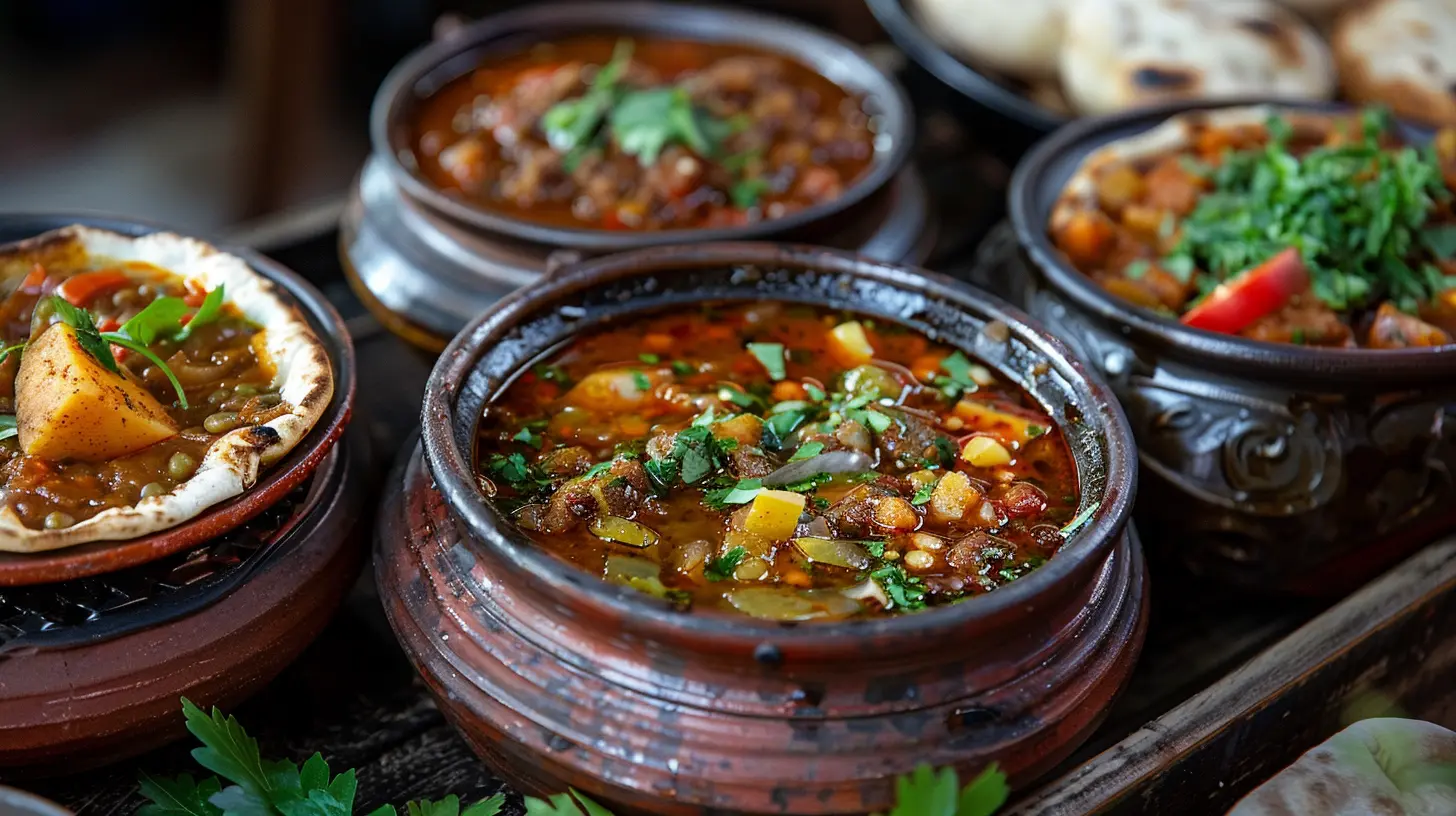Finding Comfort in Global Soups and Stews
5 August 2025
There's something universally heartwarming about a bowl of soup or stew. Think about it—whether you're curled up under a blanket on a rainy day or sitting at a bustling street-side stall halfway across the world, that first spoonful has a way of wrapping you in a cozy hug. It’s not just about flavor; it’s about feeling. It’s about memories, culture, home, and healing—all simmered into a single bowl. Today, we're taking a mouthwatering journey around the globe to discover how different cultures find comfort in soups and stews.

Why Soups and Stews?
Let’s be real for a second—soups and stews are kind of magical. They’re slow-cooked alchemy that transforms simple ingredients into soul-satisfying masterpieces. Whether it’s your grandma’s chicken soup when you’re sick or a bold, spicy stew served on a cold mountain trek in Nepal, they hit a level of emotional nourishment that’s hard to beat.In every culture, these brothy wonders do more than fill bellies. They tell stories, preserve traditions, and connect generations. And honestly, isn’t that what food is all about?
Asia: Where Flavor Meets Tradition
1. Pho – Vietnam’s Love in a Bowl
If you've ever had a steaming bowl of pho, you know it's not just a meal—it's an experience. The rich, aromatic beef broth, rice noodles, fragrant herbs, and thin slices of meat make this Vietnamese dish unforgettable.But it’s more than just ingredients. Pho is often a breakfast food in Vietnam, and families pass down recipes like they would heirlooms. It's a morning ritual, a street-side comfort, and a symbol of Vietnamese identity.
2. Samgyetang – Korea’s Health Potion
Imagine a whole young chicken stuffed with glutinous rice, ginseng, garlic, and jujubes, gently boiled into a rejuvenating brew. That’s Samgyetang for you. Koreans swear by it during the hottest days of summer, believing it helps restore energy and combat heat exhaustion—a concept called iyeol chiyeol, or “fighting heat with heat.”It's not just food; it’s medicine, tradition, and care rolled into one pot.
3. Tom Yum – Thailand’s Bold, Spicy Hug
Tom Yum is not subtle. It’s tangy, spicy, and full of attitude. This Thai soup made with lemongrass, kaffir lime leaves, galangal, and chili is a rollercoaster of flavors—and that’s exactly why it’s such a comfort food for many.When you’re feeling under the weather or just emotionally drained, a bowl of Tom Yum can almost shock you back to life. It's like a firework show for your taste buds.
Europe: Hearty Bowls for Cold Weather Comfort
1. Borscht – Eastern Europe’s Ruby Red Remedy
Don’t be fooled by the color. Borscht, made primarily with beets, is a staple across countries like Ukraine, Poland, and Russia. This sweet-and-sour soup often contains beef or pork, cabbage, onions, and sometimes even apples.It’s a rustic, humble dish that reflects the resilience of the people. Served hot or cold, with a hefty dollop of sour cream, borscht is the beating heart of Eastern European kitchens.
2. French Onion Soup – Parisian Soul Food
Caramelized onions slow-cooked to golden perfection, rich beef broth, melted Gruyère cheese, and crusty bread—it’s practically poetry. This Parisian classic isn't just for fancy restaurants; it’s a serious comfort food that feels like getting a warm hug from your most elegant friend.It teaches us that even the most basic ingredients can become luxurious with a little love and time.
3. Ribollita – Tuscany’s Answer to Leftovers
Ribollita, which literally means "reboiled," is a thick Tuscan stew made with leftover bread, cannellini beans, and vegetables like kale and carrots. Born out of frugality, this dish proves that comfort doesn’t need to be expensive.It’s slow-cooked, hearty, and tastes like it’s been made by someone who really cares about you.
Africa: Soulful Stews with Stories to Tell
1. Egusi Soup – West Africa’s Creamy Delight
Egusi soup is rich, thick, and deeply comforting. Made with ground melon seeds, leafy greens, and seasoned meat or fish, it’s often eaten with pounded yam or fufu.The texture is luxurious, almost like a peanut stew, but with its own unique twist. Every bite connects you to centuries of African culinary wisdom. It’s communal, satisfying, and full of flavor.
2. Moroccan Harira – A Hug During Ramadan
Harira is a traditional Moroccan soup served during Ramadan to break the fast. It’s a complex mix of tomatoes, lentils, chickpeas, lamb, and warm spices like cinnamon and ginger.It’s not just for nourishment—it’s a spiritual experience. Families gather, break bread, and nourish both body and soul. You can feel the love in every spoonful.
The Americas: From Chili to Chowder
1. Chicken Soup – North America’s Universal Cure-All
You knew this one was coming. The classic chicken soup—whether it’s made with noodles, rice, or matzo balls—is almost mythic in its healing power. It's the go-to comfort food when you're sick, sad, or just cold and lonely.Every family has its version, and each version comes with its own folklore. It's a love letter in broth form.
2. Chili – Hearty, Spicy, and All-American
Thick, meaty, and often spicy, chili is a staple comfort food in the United States. Whether you're at a football game or sitting by the fireplace, chili brings a sense of warmth that’s both physical and emotional.Some like it with beans, others don't. Either way, it’s a stew that speaks to personal taste, regional pride, and a whole lot of heart.
3. Sancocho – Latin America’s Festive Stew
Sancocho is a traditional stew found throughout Latin America, especially in countries like the Dominican Republic, Colombia, and Puerto Rico. Made with meats, root vegetables, corn, and tropical flavors, it’s usually cooked for celebrations or family gatherings.It’s not a dish you make solo. You make Sancocho for a crowd, for laughter, and for sharing. The joy starts in the cooking and ends in the satisfied silence after everyone’s had second helpings.
Oceania: Island Comfort in a Bowl
1. Kokoda – Fiji’s Fresh Take on Stew
Okay, Kokoda isn’t technically a stew—it’s a Fijian ceviche made with raw fish marinated in citrus, coconut milk, chilis, and onions. But in terms of comfort? It’s off the charts.Think of it as the tropical cousin of chicken soup. Refreshing, creamy, and zingy, it’s a beachside balm for the soul.
Why Soups and Stews Make Us Feel at Home—Anywhere
So, why do soups and stews bring us so much comfort, no matter where we are?- They’re Slow Food: In a world obsessed with speed, soups and stews force us to slow down. They take time—time to cook, time to savor, and time to share.
- They’re Memory Food: One whiff can take you back to your grandma’s kitchen or a street cart in Bangkok.
- They’re Healing Food: Packed with nutrition, warmth, and love, they make us feel better—physically and emotionally.
- They’re Shared Food: These dishes are rarely made for one. They’re about gathering, connecting, and belonging.
When you're traveling, nothing feels more welcoming than a local soup or stew. It’s like the culinary equivalent of someone saying, “You’re safe here.”
How to Bring Global Comfort Into Your Kitchen
You don’t need a passport to enjoy these dishes. Here’s how to get started:- Start simple: Pick a stew or soup from a culture you're curious about. Find a basic recipe, and don’t stress over fancy ingredients.
- Use what you have: Many comfort stews are rooted in humble, available ingredients. Don’t be afraid to improvise.
- Cook with company: Invite friends or family over. Soup always tastes better when shared.
- Put your heart into it: These dishes are about emotion as much as flavor. Cook like someone you love is going to eat it—and you’ll always get it right.
Final Thoughts: One Bowl, Infinite Connections
In a world that can often feel cold and chaotic, soups and stews are little bowls of stability. They're a universal language of care, comfort, and culture. Whether it's spicy, sour, creamy, or clear, every culture has found a way to turn basic, honest ingredients into something that feeds both the stomach and the soul.So next time you’re far from home—or even when you're right in your kitchen—reach for a pot, toss in some love, and let the comfort simmer.
Because sometimes, the best way to understand a place isn’t through its monuments or museums—but through what’s served in a bowl.
all images in this post were generated using AI tools
Category:
Foodie TravelAuthor:

Ian Powell
Discussion
rate this article
2 comments
Nix McGovern
Embrace the warmth of global soups and stews, where every spoonful tells a story! These comforting dishes remind us that no matter where we are, we can find connection and joy in the simplest of flavors. Happy tasting!
November 28, 2025 at 3:47 AM
Celeste Gates
Thank you for this lovely article! It beautifully captures the warmth that global soups and stews bring to our travels. Each bowl tells a story, and I can’t wait to explore these comforting flavors!
August 6, 2025 at 2:38 PM

Ian Powell
Thank you so much for your kind words! I'm thrilled you enjoyed the article and appreciate the beauty of these comforting dishes. Happy exploring!


